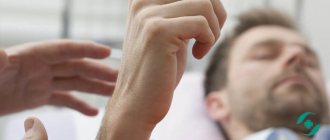Learn more about diseases starting with the letter “A”: Abdominal migraine, Absence, Brain abscess, Abuse headache, Agnosia, Pituitary adenoma, Adrenoleukodystrophy, Acalculia, Akathisia, Alternating syndromes, Amaurotic idiocy, Werdnig-Hoffmann amyotrophy, Kugelberg-Welander amyotrophy, Amnesia, Angioneurosis, Cerebral aneurysms, Anomalies of brain development, Chiari anomaly, Kimerli anomaly, Apallic syndrome.
Akathisia is a syndrome characterized by pathological restlessness, as a result of which a person experiences a systematic sensation of an urge to move. This syndrome causes discomfort, which is why the patient feels an irresistible desire to constantly be in motion. If it is impossible to move, a person begins to experience a feeling of strong and insurmountable anxiety, which he can only relieve if he starts moving again.
People suffering from akathisia are very fidgety and cannot stay in one place for a long period of time. They need to constantly move, even if this movement is completely useless.
Diagnosis of this pathology is carried out on the basis of clinical data. The choice of treatment method is directly related to the severity of the pathology and the time of its occurrence.
Causes
Most often, akathisia occurs as a side effect of taking psychotropic drugs. In more rare cases, the disease is caused by other reasons. Pathology may occur:
- While taking psychotropic drugs. In most cases, the syndrome appears from the use of neuroleptics, less often from antidepressants, sedatives, and atypical antipsychotics.
- Due to drug use. Akathisia is very often a syndrome that is present in drug addicts.
- Alcoholics. The negative effect of alcohol on the brain in long-term alcoholics leads to irreversible consequences in the subcortical ganglia, which provokes the occurrence of this syndrome.
- In patients with Parkinson's disease. Akathisia in such patients is not uncommon, but so far it has not been possible to establish whether this syndrome appears against the background of the underlying disease, or against the background of the drugs used for treatment, which act as a provoking factor.
List of antipsychotic drugs
Depending on the case (intensity of manifestation of one or another psychotic symptomatology; characteristics of the course of the disease), health status, contraindications and other factors important from the point of view of therapy, antipsychotic drugs are selected. Their dosages are adjusted during the treatment process, the drug is often changed, and symptomatic therapy is prescribed.
First generation neuroleptics
Among the typical antipsychotics used to quickly relieve acute conditions, the most well-known are:
- haloperidol;
- fluphenazine;
- flupenthixol;
- Chlopromazine;
- chlorprothixene;
- levomepromazine;
- melperon;
- perphenazine;
- zuclopenthixol;
- sulpiride
Second generation neuroleptics
Atypical antipsychotics, due to their improved action profile, are used as primary therapy for diseases with psychotic symptoms. In clinical practice, the following antipsychotics are most widely used:
- amisulpride;
- aripiprazole;
- clozapine;
- olanzapine;
- quetiapine;
- risperidone;
- sertinadole;
- ziprasidone.
Third generation neuroleptics
The most famous new antipsychotics with an innovative mechanism of action include:
- aripiprazole (first, used since 2002);
- brexpiprazole (a "modification" of aripiprazole) and cariprazine - have been used since 2015.
Pathogenesis
According to recent studies, akathisia has a much more complex developmental mechanism than isolated dopaminergic dysfunction. Several years ago, a theory arose that the decrease in dopaminergic activity in people with Parkinson's disease or in patients treated with antipsychotics may in some cases involve compensatory mechanisms. As a result, typical anxiety sensations and motor restlessness arise. In this regard, the production of adrenaline by the adrenal glands also increases significantly, which activates a feeling of insurmountable anxiety. All this together causes typical manifestations of anxiety and an irresistible desire to be in constant motion.
What it is
The analyzed disorder means a constant internal desire to move, abnormal restlessness. Subjective symptoms are manifested by a depressing urge to move, uncomfortable sensations, and increasing anxiety when motor acts are not performed. The objective component of the pathology is revealed by fussiness, marking time, restlessness, and unintentional movement.
Typically, akathisia can develop when taking antipsychotics. As a rule, it is a negative consequence of the ongoing drug treatment. The concern in question arises soon after using a new pharmacopoeial drug or increasing the dosage of a previously prescribed drug. Also, a persistent craving to move can be provoked by drugs or the addition of substances to the therapeutic strategy that enhance the effect of the main drug.
Often the appearance of akathisia is caused by Parkinson-like manifestations due to the effect of drugs on the distribution of the neurotransmitter dopamine. Some of them can directly block the transport of this neurotransmitter along dopaminergic pathways. Others act indirectly, using the opposition between the dopaminergic and serotonergic systems.
It is believed that disruptions in noradrenergic transport and opioid neurotransmission play a certain role in the mechanism of origin of the pathology. However, these transformations are rather of a secondary nature.
Individuals suffering from akathisia are characterized by constantly present feelings of excitement and internal tension, which they describe as severe anxiety. This condition is often accompanied by irritability, instability of emotions with a tendency towards a depressive mood.
Classification
It is customary to distinguish several classifications of akathisia. According to the etiological principle, the syndrome is usually divided into several different types:
- iatrogenic;
- parkinsonian;
- withdrawal symptoms;
- spontaneous;
- post-stroke.
According to the clinical manifestations of pathology, 3 types are distinguished:
- Motor – manifests itself mostly in movement disorders. Such patients feel the need for systematic movement, while there are no complaints about feelings of restlessness, anxiety, or discomfort in the body.
- Sensory-psychic. This type is characterized by complaints of deteriorating mental state, while there is no motor component. People complain of an overwhelming feeling of anxiety, fear, and panic.
- Classical. Patients with this type of disease have both complaints of anxiety and typical manifestations of motor hyperactivity. All these signs together allow specialists to make the correct diagnosis almost accurately and in the shortest time.
In any case, when choosing a treatment method, the key point is the provoking factor and the time of onset of the syndrome.
It is customary to distinguish 4 types of akathisia according to the time factor:
- Spicy. Occurs immediately after starting treatment with antipsychotics. As soon as the medication is stopped, the symptoms of the pathology gradually disappear;
- Chronic. The first signs appear a long time after the start of treatment. In 1/3 of cases, the syndrome occurs during treatment with antipsychotics. Once the patient stops taking the medications, symptoms disappear over time;
- Late. It makes itself felt no earlier than after 5-6 months. after starting medication. When treatment is discontinued, the patient begins to feel improvements, but in some cases patients may be bothered by certain manifestations of akathisia for the rest of their lives;
- Withdrawal akathisia. Appears in the first 14 days after stopping the medication and goes away within 30 to 45 days. If the symptoms of the pathology do not disappear after this time period, this indicates the presence of a late form.
Generations of antipsychotics
The leading classification of antipsychotics is based on their chemical structure and therapeutic mechanism of action. It includes three generations of antipsychotic drugs:
- first generation antipsychotics (typical antipsychotics);
- second generation antipsychotics (atypical antipsychotics);
- third generation neuroleptics (new generation neuroleptics).
Typical antipsychotics are derivatives of chemical compounds - thioxanthene, phenothiazine, buterophenone; atypical neuroleptics - derivatives of 1,4-dibenzodiazepine, substituted benzamide and other chemical structure; New generation neuroleptics are partial agonists of dopamine receptors. First-generation antipsychotics quickly and effectively relieve psychotic conditions, but have pronounced non-core actions, unlike second- and third-generation antipsychotics. New generation neuroleptics have a mechanism of action that is innovative from previous generations.
Rice. 1. Generations of antipsychotics.
First generation antipsychotics (typical)
Typical antipsychotics are usually divided into three types according to the mechanism of action on receptors that causes the antipsychotic effect - weak, moderate and strong. Weak antipsychotics have low affinity for dopamine receptors and high affinity for histamine, muscarinic and α-adrenergic receptors. Strong ones, on the contrary, actively bind to dopamine receptors and have low affinity for muscarinic and α-adrenergic receptors.
First generation neuroleptics have a pronounced antipsychotic effect. However, they may not be suitable for all patients due to lack of response to treatment (in about 3 out of 10 patients with schizophrenia, positive symptoms are not relieved) or due to the occurrence of side effects - disturbances of consciousness, dystonia, limb tremors, tardive dyskinesia.
Second generation antipsychotics (atypical)
As a rule, when prescribing treatment with antipsychotics, preference is given to second-generation drugs. Atypical antipsychotics block dopamine receptors selectively, thereby reducing the risk of developing extrapyramidal disorders. In addition, unlike typical antipsychotics, they have additional therapeutically significant positive effects:
- smooth out negative symptoms;
- reduce the risk of developing mild cognitive impairment;
- less likely to cause extrapyramidal disorders;
- do not contribute to the occurrence of tardive dyskinesia.
Some atypical antipsychotics reduce suicidal tendencies during remission due to, for example, sedation; others help to cope with anxiety and insomnia and, on the contrary, if the patient is lethargic, second-generation antipsychotics are selected that do not cause a strong sedative effect
When prescribing atypical antipsychotics, the assessment of therapeutic effectiveness and side effect profile is carried out over a period of 4–8 weeks. In particular, during this period it is necessary to monitor weight and body mass index, fasting blood glucose levels, and blood pressure. The patient should be notified by the attending physician about the first signs of diabetes mellitus, adhere to the principles of a balanced diet and engage in physical activity.
Third (new) generation neuroleptics
Third generation antipsychotics have a different mechanism of action from typical and atypical antipsychotics. The mechanism of the first generation of drugs is to block receptors, which, of course, helps to effectively stop acute and long-term psychotic conditions and provide maintenance treatment. However, residual symptoms, an individual profile of side effects and some difficulties in selecting a drug suitable for a particular patient do not allow them to become the standard for the treatment of psychosis.
The principle of action of new generation neuroleptics is partial agonism to D2- and D3-dopamine receptors, which are a weaker synthetic analogue of dopamine. Taking such drugs allows patients to reduce negative symptoms, cognitive impairment, neurological, metabolic, endocrine and other disorders, and more effectively restore the ability to live independently. In other words, the latest generation of antipsychotics have an expanded range of therapeutic efficacy and an improved safety and tolerability profile.
The principle of partial agonism of new generation antipsychotics is an innovative mechanism that has made it possible to bring the treatment of schizophrenia to a new level by achieving the following effects:
- the effectiveness of relieving positive symptoms is comparable to first and second generation antipsychotics;
- effectiveness is achieved by influencing the receptors of “weakened” dopamine, and not by blocking the receptors;
- therapeutic effectiveness against negative symptoms is determined by mild decompensation of neurotransmission in the dopaminergic system (an effect not available for first- and second-generation antipsychotics);
- the risk of extrapyramidal symptoms (EPS) is minimal or usually absent;
- have significantly improved tolerability.
Third generation antipsychotics are represented by several drugs. The first of them began to be used in 2002 (Aripiprazole), the subsequent ones - in 2015 (for example, Brexpiprazole, Cariprazine). Naturally, the list of newer antipsychotics will expand, but you need to know that the Food and Drug Administration (FDA) designates their mechanism of action as “unknown.”
Symptoms
If akathisia develops in the classic form, then it is characterized by the presence of anxiety combined with hyperactivity. At the very beginning of the development of the pathology, the patient is disturbed by motor disturbances in the legs, which is why the person cannot be at rest while standing, lying or sitting. Such patients are in constant motion, sometimes even marking time in the same place. If the patient occupies a horizontal position, then he constantly changes the position of his body; if he is in a sitting position, then he constantly swings his legs.
Over time, the pathology progresses, causing akathisia to spread from the lower extremities to the upper extremities. In the absence of proper treatment, the patient begins to wriggle his whole body, move in jumps, and in extreme cases, even involuntary movement of the eyeballs is observed.
Sensory akathisia manifests itself in the presence of unpleasant sensations throughout the body. The mental component is expressed in excessive anxiety syndrome, impossibility, tension. Patients claim that while they are in motion, it becomes much easier for them, but as soon as they stop, anxiety and fear begin to increase, which acts as a provoking factor for the start of new movements.
Akathisia often provokes sleep disturbances. A pathology that occurs over a long period of time without proper treatment causes significant changes in a person’s character. Such patients become suspicious, anxious, annoying, and nervous. Unrecognized pathology in time provokes the development of a number of complications.
Clinical picture
Akathisia usually has two main components. Moreover, one of them is leading, and the second is not so strongly expressed.
So, the first component is called sensory or cognitive. It manifests itself in the form of uncomfortable internal sensations that force a person to perform certain actions. The patient is aware of these symptoms and can keep them under control.
The sensory component usually manifests itself in the form of a feeling of anxiety, tension, and increased irritability. Sometimes people experience clear somatic disorders - for example, pain in the legs or lower back.
The second component is motor. It consists in the fact that patients perform repetitive standard movements, which are individual for each person. Some people constantly walk, others sway their bodies or kick their feet, and still others itch or pick their nose.
Quite often, at the very beginning of a motor act, people cry out. They can also make mooing sounds. After motor activity begins to decline, vocalization disappears. It may appear at the beginning of the next motor act.
Complications
Akathisia very often becomes the reason for the patient to refuse treatment due to a negative attitude towards the procedures. Due to restlessness, the patient simply cannot carry out the entire necessary range of therapeutic measures. The syndrome very often provokes depression, aggressive behavior, and suicidal thoughts. Such patients may even pose a danger to people around them. Sometimes patients try to help themselves on their own: to relieve all manifestations of the pathology, they begin to abuse alcohol and smoking, which over time leads to the development of addictions, but in no way to the disappearance of the pathology.
Diagnostics
It is not easy to identify akatisic syndrome at the very beginning of its occurrence. Patients often ignore the first symptoms of pathology, restrain motor manifestations, and simply cannot express all the unpleasant sensations in words, because they just don’t understand what’s happening to them. Sometimes a symptom of pathology is an exclusively negative attitude of the patient towards the upcoming treatment. All examination methods - MRI, CT, EEG, REG - are informative only in terms of differential diagnosis.
A psychiatrist can make the correct diagnosis. In some cases, the doctor may resort to interviewing relatives or personal observation of the patient without his knowledge, because the patient may deliberately hide the motor manifestations of such a dangerous pathology.
Treatment
Before starting treatment for akathisia, the doctor must identify the specific type of pathology. Due to the fact that in most cases the syndrome is iatrogenic in nature, a specialist can review the prescribed treatment regimen and exclude the use of certain medications. Either a dose reduction or a complete replacement of drugs was carried out. Almost all patients are advised to take magnesium supplements. Treatment is carried out with the combined use of the following main groups of pharmaceuticals:
- central anticholinergics;
- beta blockers;
- GABAergic agents;
- 5-HT2 blockers;
- antiadrenergic agents;
- dopaminergic drugs.
Prognosis and prevention
The success of treatment is directly related to when the syndrome was recognized - the earlier this was done, the easier the therapy will be and the faster the syndrome will stop bothering the patient. In most cases, with the correct therapeutic tactics, patients recover and no associated complications arise.
Due to the fact that akathisia occurs mainly while taking medications, preventive measures include strict adherence to all recommendations of specialists on the use of antipsychotic medications and antidepressants.
Information sources:
1. Drug dyskinesias/ Levin O.S.// Modern therapy in psychiatry and neurology. — 2014 — No. 3. 2. Drug-induced extrapyramidal disorders/ Shtok V.N., Levin O.S.// In the world of drugs. – 2000 – No. 4. 3. Pharmacotherapy in neurology / Shtok V.N. — 1995









